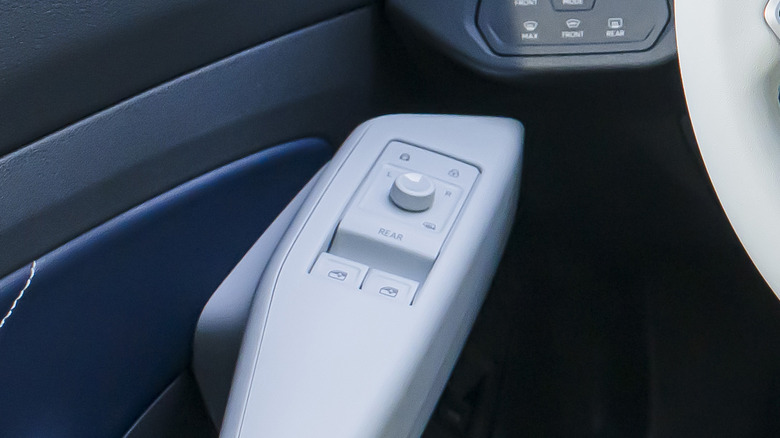This Annoying New Car Trend Is On The Rise, And We Can't Stand It
After getting the details about Volvo's latest all-electric vehicle, the EX30 compact SUV, there's much to be excited over. It offers seating for five adults and an estimated 265 to 275 miles on a full charge, starting at less than $35,000. However, traditionalists may be slightly less enthusiastic about its power window controls.
Volvo says the EX30's cabin is "Inspired by the uncluttered elegance of a Scandinavian home." That uncluttered elegance only provides the driver with a pair of conventional left and right power window switches to control the front and rear windows. To toggle control between the front and rear windows, there's a lighted touch sensor just ahead of the up and down switches in the driver's door armrest. Volvo isn't even the first carmaker to implement this style of window switch — that dubious honor goes to Volkswagen and its ID.4 — so it's becoming an unwelcome trend.
The benefit of this new methodology to automakers isn't immediately apparent. One could speculate that money is saved by eliminating two of the four window switches at the driver's door. Still, those potential savings are somewhat (or completely) negated by the need for the lighted touch sensor to toggle between the front and rear.
The other potential reasoning is that since drivers typically operate only the front windows from their set of controls, the possibility of lowering one of the rear windows by accident — something we've all done — is eliminated if the selector switch remains in front mode.
The touch sensor lacks a tactile signal
While keeping controls focused on the front windows has merit, significant criticism stems from the execution. Because the touch sensor is flat and not tactile, a driver needs to do one of two things to determine whether it's set to control the front or rear windows: They either need to take their eyes off the road to glance at the switch, or they can test raise or lower one of the windows a small amount. It's an unnecessarily complicated process.
It seems that if VW, Volvo, and others are going to persevere with only a pair of left and right window switches at the driver's control, the method of selecting front or rear needs to be more tactile, like perhaps a button that has up and down positions, or a rocker switch that's engaged in the front or rear position. This tactic is already employed with power-adjustable side mirrors, which typically only have a single control pad with an actual knob or switch to select left or right operation.
We get that carmakers are implementing technology at light speed, and power window switches are a design facet that hasn't been updated in decades. Still, VW and Volvo's current execution leaves something to be desired. We'd say the next step will be putting the window controls on the car's infotainment screen, it's best not to give automakers any ideas.
